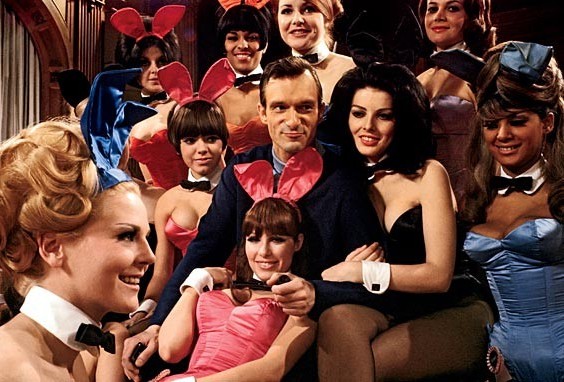Playboy magazine died last week, at age 66, of complications related to the novel coronavirus. The magazine, which last year became an ad-free quarterly costing $25, was losing $5 million a year. A relic of an era when pornography could only be found on paper, Playboy kept publishing only due to the sentimentality of its founder, Hugh Hefner, who died in 2017 at age 91. Its Spring 2020 issue will be the last before it goes online-only.
Playboy was a Chicago creation. While the Midwest may seem like an unusual birthplace for a magazine that came to be called “the Bible of the sexual revolution,” Playboy’s style and ethos were very much influenced by the city’s culture and history. The Playboy Philosophy, Hefner’s megapart manifesto of male liberation, expressed the longings of a square young man who grew up in a square big city.
Chicago hadn’t always been squaresville, though, and Hef knew it. When Hefner was born, in 1926, Chicago was the city of Louis Armstrong and Al Capone. Ernest Hemingway, then the most famous figure in American literature, was from Oak Park. Chicago was speakeasies and jazz and gangsters, the town that, in the words of a song written in that era, “Billy Sunday couldn’t shut down.” Choreographer Bob Fosse, Hefner’s exact local contemporary, tried to recreate that racy city in the musical Chicago, and Hefner tried to recreate it in Playboy.
Hefner grew up at 1922 N. New England Ave., in the Galewood neighborhood, attending Sayre Elementary and Steinmetz High School. (Hefner remained so fond of Steinmetz that in the 2010s, he donated $7,500 a year to print the school newspaper, the Steinmetz Star.) As a boy, he spent his Saturday afternoons at the Montclare Theater, 7133 W. Grand Ave., watching glamorous Hollywood musicals and dramas, which were meant as an escape from the dreary privation that descended on America in the 1930s.
“There is no way to underestimate the effect movies had on me as a boy,” Hefner once told the Tribune. “My dreams came alive at the Montclare Theater.” He would remember watching “all those images of the Jazz Age, the flappers … and thinking that I’d missed the party.”
Hefner devoted his career to restarting that party. For founding a magazine devoted to sex, cocktails, art, stereo equipment, and literature in 1953, Hefner was often considered a man ahead of his time.
But in fact, he was a bit of a reactionary.
The 1960s are remembered as America’s decade of sexual and cultural liberation, but those trends began in earnest in the 1920s. They were simply interrupted by the Great Depression and World War II, the difficult years of Hefner’s dissatisfied boyhood. Hefner’s greatest contribution as a cultural figure was serving as a bridge between those eras. He originally gave his magazine the crude name Stag Party. When it turned out that was taken, he came up with Playboy. Hefner’s wife told him the word “playboy” evoked a debonair bachelor of the Jazz Age: exactly what he wanted.
The political establishment of the 1950s didn't appreciate Playboy in the way that Big Bill Thompson, Chicago's colorful Prohibition-era mayor, might have. The Chicago of Hefner’s young manhood, the city to which he returned after the University of Illinois and the Army, was, according to a 2009 story in this magazine, “a rust-belt city under the sway of its newly crowned potentate — da’ mayor — Richard J. Daley, a national political player, but a buttoned-up old-school square who banished underlings who fell short of his deeply Catholic, almost fusty sense of propriety.”
Daley, whose campaign slogan was “A Family Man for a Family City,” found Hefner’s magazine so offensive he refused to make Soldier Field available for the first Playboy Jazz Festival.
Hefner himself wasn’t Catholic. He grew up in what he would remember as a repressed Methodist household. While Hefner’s detractors would later observe that he applied a grim Protestant work ethic to amassing women, money, and art — Time magazine called him a “dour sybarite” — his middle class, Midwestern background was the source of Playboy’s mass appeal. At its peak, in the early 1970s, Playboy sold seven million copies a month.
Playboy was always middlebrow: a square’s idea of sophistication. Even when it tried to be highbrow, it was middlebrow. The magazine was notorious for publishing “second-tier fiction by first-rate writers.” If John Updike couldn’t sell a short story to The New Yorker, he could always peddle it to Playboy.
Now, a hundred years after the decade that inspired it, Playboy is gone. As Chicago has come to symbolize the Jazz Age through the musical it inspired, Chicago-born Playboy symbolized the sexual revolution.
But that was never its creator’s intention. He just wanted to bring back the Chicago he’d been born in, the Chicago he wished he’d been part of.



